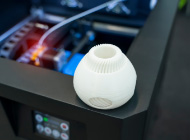
In order to develop a product successfully, most product designers create prototypes for testing. Although porototyping is crucial for product development, a typical prototyping process can take weeks or even months to complete depending on the method used and complexity of the product.
In this matter, rapid prototyping is utilised. Rapid prototyping is faster and a more cost-effective method compared with conventional prototyping. To learn more about rapid prototyping, here is a blog discussing how it works.
An overview of "Rapid Prototyping"
Technically speaking, rapid prototyping (RP) is a group of techniques used to fabricate a model quicker than the normal prototyping process. It enables engineers to shorten a design and development cycle. It has also been referred to as solid free-form manufacturing, layered manufacturing, and computer automated manufacturing.
Rapid prototyping technology is classified as an additive process. Based on 3D model data, materials are combined layer upon layer to produce an object. The materials used for this process are photopolymer, thermoplastic, and adhesives.
Rapid prototyping is being utilised in most industries, and its benefits are widely known.
Benefits of Rapid Prototyping
With today’s advanced technology, rapid prototyping can provide immense benefits to:
- Product Designers and Engineers
- Ability to experiment with physical objects regardless of its complexity, in a short time
- More organic and sculptured shapes can be accommodated
- Easier to detect flaws in the early developmental stage
- Consumers
- Consumers can contribute ideas to the design
- Consumers can buy products that suit their needs better
- Savings in cost of final product
Fundamentals of Rapid Prototyping
There are 4 primary areas for the development of rapid prototyping:
- Input
Input refers to describing the physical object with 3D data. Its starting point can be a computer model or physical model.
A computer model is created by a CAD system while the physical model requires data acquisition through "reverse engineering".
- Method
The method that is employed by each RP business is classified into different categories:
- Photo-curing
- Cutting and gluing/joining
- Melting and solidifying/fusing and joining/binding
- Materials
The initial state of the prototype material can be either in solid state, liquid state or powder state. It can also be in the range of paper, nylon, wax resins ceramics and metals.
- Applications
Rapid prototyping applications can be grouped into design, engineering, analysis and planning, tooling and manufacturing. Rapid prototyping can also benefit various industries such as in aerospace, automotive, biomedical, electrical products, etc.
Techniques of Rapid Prototyping
3D printing is a process of making three-dimensional solid objects from a digital file. This is achieved using an additive process. Additive process is done by laying down successive layers of material until a final product is created. 3D printing enables you to produce complex shapes using fewer materials. Below are some experimental RP methodologies that are used nowadays.
- Fused Deposition Modelling
Fused Deposition Modelling is a process used to construct the product directly from 3D CAD data. This process involves binding thermoplastic material layer by layer.
Thin laminates such as paper, plastic sheet or metal foil are laid out to build a platform. A computer controlled cutting device traces out the patterns and crops off excess materials.
- Stereolithography (SLA)
Stereolithography is based on a selective polymerisation of a photosensitive resin. Basically, a thin layer of liquid plastic (polymer) is exposed on a perforated platform. An ultraviolet (UV) laser beam is then focused on the top layer of the platform and prints the pattern of the product.
Stereolithography is the first rapid prototyping technique. Apart from that, it is the most widely used method today. It is also an inexpensive procedure since it uses light-sensitive liquid polymer.
- Selective Laser Sintering (SLS)
A high-powered laser beam melts and fuses powdered material that is spread on a layer. Furthermore, the powdered material is measured in accurate amounts and spread by a rotating roller table.
Methodology of Rapid Prototyping
All rapid prototyping techniques undergo these basic steps:
- Create a CAD (Computer Aided Design) model.
In this step, the object (to be built) is formed using a CAD software package. Designers and engineers utilise 3D objects because it is more accurate than wire-framed models such as AutoCAD. CAD model creation also yields to better results.
- From a CAD model, the design is converted to STL format.
In order to establish consistency, STL format has been adopted as a standard format in rapid prototyping. The STL format represents a 3-dimensional surface geometry without any representation of texture, colour or other CAD attributes.
- The rapid prototyping machine processes the .stl file and divides the object into a series of thin slices stacked on top of one another.
The 3rd step, a pre-process database prepares the STL file to be sliced. The database slices the STL model into layers from 0.01mm to 0.7mm thick depending on the build technique and accuracy required.
- The model is constructed one layer over the other.
After the first layer of the physical model is done, the rapid prototyping machine builds another layer on top of the first layer. This process is repeated until the model is completed. Most of the machines used are autonomous and only require low level of human intervention. However, supportive structures and experience is required to stop distortion.
For post-processing, the prototype is removed from the machine. Any supports that are in the product are also detached. Moreover, prototypes may require cleaning and surface treatment such as sanding, sealing or painting to improve appearance and durability.
Conclusion
You are now educated about how rapid prototyping works. By using rapid prototyping, product designers and engineers can quickly produce a prototype for use while comsumers can make idea come true a lot easier than before.
In the process of rapd prototyping, if you require mechanical design and drafting services, there are reliable manufacturers who can provide prototyping services in Sydney Australia.








